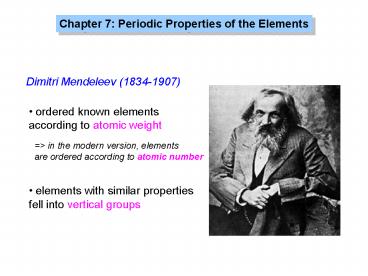Chapter 7: Periodic Properties of the Elements - PowerPoint PPT Presentation
1 / 16
Title:
Chapter 7: Periodic Properties of the Elements
Description:
Chapter 7: Periodic Properties of the Elements Dimitri Mendeleev (1834-1907) ordered known elements according to atomic weight = in the modern version, elements – PowerPoint PPT presentation
Number of Views:664
Avg rating:3.0/5.0
Title: Chapter 7: Periodic Properties of the Elements
1
Chapter 7 Periodic Properties of the Elements
Dimitri Mendeleev (1834-1907)
ordered known elements according to atomic
weight
gt in the modern version, elements are ordered
according to atomic number
elements with similar properties fell into
vertical groups
2
Chapter 7 Periodic Properties of the Elements
atomic radius increases
atomic radius increases
3
Chapter 7 Periodic Properties of the Elements
What happens to the atomic radius along a period ?
The effective nuclear charge increases along a
period and draws in the surrounding electrons,
making the atom more compact
Fluorine
Lithium
4
Chapter 7 Periodic Properties of the Elements
What happens to the atomic radius as we go down a
group ?
more electron shells are added
atomic radius increases
5
Chapter 7 Periodic Properties of the Elements
which radius is largest?
Sr
which radius is smallest?
Ne
6
Chapter 7 Periodic Properties of the Elements
cations are always smaller than their parent
atoms
anions are always larger than their parent atoms
7
Chapter 7 Periodic Properties of the Elements
Why does the ionic radius decrease along the
following series?
O2- F- Na Mg2 Al3
- all of these ions are isoelectronic (Ne
electron configuration)
- nuclear charge increases, making the ions with
the highest - atomic number (most protons!) the most compact
8
Chapter 7 Periodic Properties of the Elements
Which of the following has the largest radius?
S2- S Ca2 O2-
9
a. S2- b. S c. Ca2 d. O2-
Ca2
vs.
S2-
isoelectronic, Ca2 has higher nuclear charge gt
more compact
S2- has the largest radius
10
Chapter 7 Periodic Properties of the Elements
Order the following according to increasing
radius
Ar P Ga3 S
11
Ar P Ga3 S
smallest radius
Ga3
Ga3 is more compact than Ar (isoelectronic)
largest radius
P
atomic radius decreases with atomic number in
same period
Ar lt S
atomic radius decreases with atomic number in
same period
Ga3 lt lt P
Ar lt S
12
Chapter 7 Periodic Properties of the Elements
Order the following according to decreasing
radius
Mg2 Ne F F-
13
Mg2 Ne F F-
smallest radius
Mg2
Mg2 is more compact than Ne (isoelectronic)
largest radius
F- gt F
anions are always larger than their atoms
F gt Ne
atomic radius decreases with atomic number in
same period
F- gt gt Mg2
F gt Ne
14
Chapter 7 Periodic Properties of the Elements
Why does the ionization energy increase sharply
after removal of the 5th electron for Nitrogen?
What would a similar graph look like for
beryllium (Be)?
core electrons are much harder to remove than
valence electrons !
Nitrogen
15
Chapter 7 Periodic Properties of the Elements
Ionization Energies measure the energy required
to remove electrons from an atom in the gas phase
1st ionization energy energy required to remove
1st electron
I1 419 kJ/mol
K (g)
K (g) e-
Mg (g) e-
I1 738 kJ/mol
Mg (g)
2nd ionization energy energy required to remove
2nd electron
3rd ionization energy energy required to remove
3rd electron
16
Chapter 7 Periodic Properties of the Elements
Trends in 1st Ionization Energies
1st ionization energy
17
Chapter 7 Periodic Properties of the Elements
General Properties of Metals
- compounds made of metals and non-metals tend to
be
ionic substances
2 Ni (s) O2 (g) ? 2 NiO (s)
- Metal oxides dissolve in water to make metal
hydroxides
Na2O (s) H2O (l) ? 2 NaOH (aq)
18
Chapter 7 Periodic Properties of the Elements
- Metal oxides tend to make basic solutions in
water
Na2O (s) H2O (l) ? 2 NaOH (aq)
- Non-metal oxides tend to make acidic solutions
in water
natural water is always slightly acidic !
CO2 (g) H2O (l) ? H2CO3 (aq)
SO2 (g) H2O (l) ? H2SO3 (aq)
contribute to acid rain!
SO3 (g) H2O (l) ? H2SO4 (aq)































